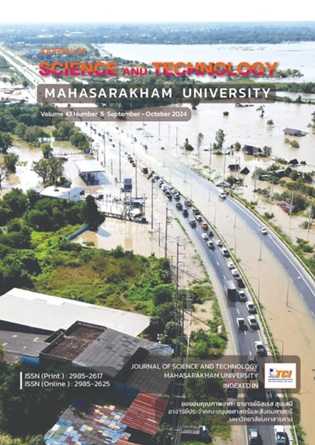Production of compost from concentrated latex sludge as a soil amendment
Main Article Content
Abstract
This research investigated the production of compost from concentrated latex sludge as a conditioner and studied the properties of the compost in four different experiments using different ratios of composting ingredients: concentrated latex sludge, urea, and cow manure. The different ratios were used were: 3.0:0:0, 2.0:0.5:0.5, 2.0:1.0:0, and 2.0:0:1.0, respectively. All compost formulations were analyzed for their properties, specifically the average of: temperature, moisture content, pH, electrical conductivity, and organic matter. It was shown that a suitable compost fermentation period lasted for 50 days. The properties of the compost derived from concentrated latex sludge included an average temperature range of 29.80-38.06 °C, the percentage of moisture content ranged from 78.92% to 81.82%, pH was between 8.34 – 8.48, electrical conductivity (EC) was 3.18 – 6.13 decisiemens/meter, and quantity of organic matter ranged from 38.51%-42.71%. Among treatments, the compost in the second treatment with the ratio 2.0:0.5:0.5 was found to be the most suitable, showing the greatest economic value and investment return due to its superior N: P: K content which was the highest in the experiment. Specifically, the percentage contents of N, P, K were 4, 0.95%, and 0.39% respectively. In analysis of economical value, the compost yielded a return on investment 48.47% and a net profit of 1,537.80 Baht per production cycle. In conclusion, the production of compost from concentrated latex sludge contained primary micronutrients and had potential for promoting plant growth as a soil conditioner.
Article Details
References
กรมวิชาการเกษตร. (2548). วิธีวิเคราะห์ปุ๋ยอินทรีย์. แหล่งที่มา: http://lib.doa.go.th/multim/e-book/EB00061.pdf. (10 กันยายน 2566)
กรมวิชาการเกษตร (2557). ประกาศกรมวิชาการเกษตร เรื่อง มาตรฐานปุ๋ยอินทรีย์. https://doi.nrct.go.th.
ณิชาภา มินาบูลย์ ประพัฒน์ สีใส และ อภิเสฏฐ์ สุวรรณสะอาด. (2565). การพัฒนาชั้นรองพื้นทางบดอัดจากกากขี้แป้งยางผสมซีเมนต์และกระดาษหนังสือพิมพ์เพื่อการเพิ่มมูลค่าของเหลือทิ้งจากอุตสาหกรรมน้ำยางข้น. วารสารวิทยาศาสตร์และเทคโนโลยีรัตนโกสินทร์, 4(2): 53-64.
ณัฐพล ศรีเมือง. (2553) การเปลี่ยนแปลงทางเคมี กายภาพ และจุลชีววิทยาในการหมักปุ๋ยผักตบชวา. วิทยาศาสตรมหาบัณฑิต. มหาวิทยาสงขลานครินทร์.
ธเรศ ศรีสถิต. (2553). วิศวกรรมการจัดการมูลฝอยชุมชน. สำนักพิมพ์จุฬาลงกรณ์มหาวิทยาลัย.
นภารัตน์ ไวยเจริญ สมทิพย์ ด่านธีรวนิชย์. (2566) การใช้ประโยชน์จากกากขี้แป้งจากโรงงานน้ำยางข้นเพื่อผลิตปุ๋ยสำหรับในการปลูกหญ้านวลน้อย. วารสารวิทยาศาสตร์และเทคโนโลยี, 4(2): 53-64.
นภารัตน์ ไวยเจริญ. (2554). การทำปุ๋ยหมักของมูลฝอยจากตลาดสดในเขตเทศบาลหาดใหญ่ จังหวัดสงขลา.มหาวิทยาลัยสงขลานครินทร์.
บัญชา รัตนีทู. (2565). ผลของการใช้ปุ๋ยหมักจากวัสดุอินทรีย์ผลพลอยได้จากโรงงานสกัดน้ำมันปาล์มต่อการเจริญเติบโตและผลผลิตของผักคะน้า. วารสารแก่นเกษตร (ฉบับพิเศษ 1): 463 - 467.
ประชาชาติธุรกิจ. (2564). ไทยแชมป์โลกผลิตน้ำยางจ่อตั้ง ตลาดล่วงหน้า กำหนดราคา. ออนไลน์]. แหล่งที่มา: https://www.prachachat.net/.
(10 กันยายน 2566)
ประไพพรรณ จันทร์ทิพย์. (2559). การทำปุ๋ยหมักผักตบชวาร่วมกับกากตะกอนส่วนเกินจากระบบบำบัดน้ำเสียของโรงงานน้ำยางข้นและกากตะกอนจากโรงงานยางแท่ง STR 20 .วิทยาศาสตรบัณฑิตมหาวิทยาลัยสงขลานครินทร์.
ภิรมย์ขวัญ ชิณวงศิ์ เกริกชัย ธนรักษ์ และ อรวรรณ ศิริรัตน์พิริยะ (2557). ผลของการใช้กากขี้แป้งเป็นแหล่งแมกนีเซียมเพื่อการเติบโตของปาล์มนํ้ามันระยะอนุบาลหลัก.ใน การประชุมวิชาการเสนอผลงานวิจัยระดับบัณฑิตศึกษาครั้งที่ 14 (น. 776-782). วิทยาลัยการปกครองท้องถิ่น มหาวิทยาลัยขอนแก่น.
วลัยพร ผ่อนผัน. (2547). การใช้ประโยชน์กากขี้แป้งจากโรงงานผลิตน้ำยางข้นในรูปสารบำรุงดิน. วิทยาศาสตรมหาบัณฑิต. จุฬาลงกรณ์มหาวิทยาลัย, 31(2): 53-70.
วิจิตรา นามจิตร. (2563) การปรับปรุงคุณภาพและการทดสอบประสิทธิภาพของ ปุ๋ยอินทรีย์อัดเม็ดที่มีส่วนผสมของแร่ลีโอนาร์ไดต์ต่อการเจริญเติบโตและผลิตของข้าวโพดหวาน. วิทยาศาสตรมหาบัณฑิต. มหาวิทยาลัยพะเยา.
ศิรินทรา วันดี. (2552). การศึกษาการนำของเสียโรงงานผลิตยางแท่ง (STR20) มาหมักปุ๋ย. วิทยานิพนธ์, มหาวิทยาลัยสงขลานครินทร์.
เสาวนีย์ ก่อวุฒิกุลรังษี ยุพดี ชัยสุขสันต์ สมพร ประเสริฐส่งสกุล และ สะเราะ นิยมเดชา. (2553). การแปรสภาพกากขี้แป้งจากอุตสาหกรรมน้ำยางข้นและการใช้ประโยชน์มหาวิทยาลัยสงขลานครินทร์.
สถาบันพลาสติก. (2559). รายงานการศึกษาเชิงลึกเรื่อง ความเป็นผู้นำในอุตสาหกรรมน้ำยางข้นและผลิตภัณฑ์จากน้ำยางข้นของไทย. https://rubber.oie.go.th/ArticleCategory.aspx?acid=3016.
Ameen, A.; Ahmad, J. & Raza, S. (2016). Effect of pH and moisture content on composting of Municipal solid waste. Int. J. Sci. Res. Publ. 2016, 6, 35–37.
AOAC. (2000). Official Methods of Analysis. 17th. Gaithersburg, MD, Maryland, USA, AOAC International. Garcia Gomez A. Roiang
Astari Dewi Hutami & Dwi Indrawati, Ratnaningsih. (2020). Bioconversion of cow dung and aassava peels with the vermicomposting method. International journal of scientific and technology research. volume 9(1), 2277-8616.
Jutarut Iewkittayakorn Juntima Chungsiriporn & Nirattisai Rakmak. (2018). Utilization of waste from concentrated rubber latex industryfor composting with addition of natural activators. Songklanakarin J. Sci. Technol. 40 (1), 114-120.
Chennaou, M.; Salama, Y.; Aouinty, B.; Mountadar, M. & Assobhei, O. (2018) Evolution of bacterial and fungal flora during In-Vessel composting of organic household waste under air pressure. J. mater. Environ. Sci. 9, 680–68
Garciaa, M. Raesb, D. Jacobsen, S. (2003). Evapotranspiration analysis and irrigation requirements of quinoa (Chenopodium quinoa) in the bolivian highlands. agricultural water management, 60 (2003), 119–134.
Hafeez, M.; Gupta, P.; Gupta, Y.P. (2018) Rapid Composting of Different Wastes with Yash Activator Plus. Int. J. Life Sci. Sci. Res. 2018, 4, 1670–1674.
Huang, G.F., Wong, J.W.C., Wu, Q.T. & Nagar, B.B. (2004). Effect of CN on Composting of pig manure with sawdust. waste management, 24,: 805-813.
Wanseng, W., Danteravanich, S., & Chevakidagarn, P. 2017, Investigation of excess sludge generated from activated sludge treatment plant of concentrated latex factories: An investigative case study in Southern Thailand, Environment and Natural Resources J.,15(2),:51-61


